Excavated 1908 in Phaistos, Crete, this enigmatic artifact is dated about 1600 BCE, the time of the Minoan civilization. This mysterious object, the most famous undeciphered artifact in archaeology, has defied decipherment attempts for over 100 years.
Published since 1997 my solution to this fantastic puzzle is embraced by many, contested by others and even ridiculed by some. It was ignored by archaeologists for years, studied by anthropologists for years, and has been widely and secretly researched, having slipped in the back door of colleges and universities everywhere. My solution has been difficult for some to accept because it conflicts with the current view of Minoans as being much less intelligent than we are.
Were the Minoans really less intelligent or could we have devolved so that we cannot even recognize their brilliance? Whatever we may think we know about intellgence, we know almost nothing at all about consciousness, the greatest mystery in the universe, except that we believe personal consciousness is composed of two parts; the conscious mind and the unconscious mind. The conscious mind uses the intellect to come up with logical solutions to problems, and the unconscious mind uses dreams to engender great ideas and find solutions to impossible problems. The dream world is its own unique reality, and how the intellect works with the unconscious mind and with dreams is a great mystery and one that is more to be experienced than understood.
Recently asserted by European researchers that we have lost 14 IQ points over 115 years since the Victorian Age, how many have we lost over 3,600 years since the Mediterranean Bronze Age and the creation of the nearly indecipherable Phaistos Disk? Perhaps people in the ancient past had a stronger connection to the unconscious mind than we do, and this made them more intelligent than we think they had a right to be. Their accomplishments seem impossible to us because we lost the power of that connection a long time ago. So, we deny they could have done some of the things they did, such as build the Great Pyramid. Instead, we say aliens did it.
How old is this theory that aliens built the Great Pyramid? We assume it is part of our modern mythology, but perhaps it is an ancient theory. The Great Pyramid was built at least 1,100 years before the creation of the Phaistos Disk, about 2700 BCE which is also the date of the beginning of the Minoan civilization. The pyramid might be very much older, and the Minoans may have had their own "aliens built it" theory, since it was built in their ancient past. Perhaps the creator(s) of the Phaistos Disk used the Disk to express an opinion on this theory. If the Phaistos Disk should provide us with an historical account of how the pyramid was built or how the Minoans thought it was built, or even that the Minoans helped build it, then this would indicate they possessed much greater intelligence than we willlingly acknowledge.
 This pictograph on the Phaistos Disk that looks like a carpenter's square appears exactly six times on one side of the two-sided Disk. The pictograph is #17 in the right column of the pictographs found on the Disk. Connect these matching pictographs with lines to excavate a pyramid, drawn as in geometry to indicate four sides. The Great Pyramid Is just across the water from Crete. Is this new pictograph the Great Pyramid? Could the Minoans have known how it was built or is this a speculation on how it was built?
This pictograph on the Phaistos Disk that looks like a carpenter's square appears exactly six times on one side of the two-sided Disk. The pictograph is #17 in the right column of the pictographs found on the Disk. Connect these matching pictographs with lines to excavate a pyramid, drawn as in geometry to indicate four sides. The Great Pyramid Is just across the water from Crete. Is this new pictograph the Great Pyramid? Could the Minoans have known how it was built or is this a speculation on how it was built?
Phaistos Disk and my exact tracing of it
This pyramid is a new, larger and hidden pictograph, #49, on the Disk, perhaps meaning Great Pyramid. Combined with the carpenter's squares that produced it, I suggest this meaning:
 "Carpenter's squares (geometry) built this." (Not aliens :)
"Carpenter's squares (geometry) built this." (Not aliens :)
The intelligence involved in the creation of this Disk artifact starts to become obvious, but not so obvious is the awareness of the unsconscious mind, hidden beneath the surface of intellegence, that sees what the conscious mind overlooks. The pyramid, hidden beneath the surface of the disk, was there all the time but invisible. And. like the unconscious mind, the pyramid exists in its own dimension, part of a larger one but hidden and somehow separate.
The unconscious mind is another animated part of you, existing beneath your awareness like the subterranean chamber of the Great Pyramid. You won't know how to find it and access it without exploring the interior of the self, like Minoans exploring the inside of the Great Pyramid. The hidden entrance to the subterranean chamber exists - the little two-way door into the unconscious mind - it's just a question of how find it. We find it naturally by going to sleep, by putting the conscious mind on hold and entering the realm of the unconscious and the world of dreams, but we can learn how to consciously merge the two and gain the benefits of both, as I believe the Minoans did.
 Excavate the interior of the Great Pyramid showing the entrance to the subterranean chamber by connecting with lines all the 10 Golden Fleece pictographs (left) on Side 1. This is pictograph #9 in the right column. Suddenly appears a new pictograph, #50, the Great Pyramid with a view of the interior showing the entrance leading to the subterranean chamber.
Excavate the interior of the Great Pyramid showing the entrance to the subterranean chamber by connecting with lines all the 10 Golden Fleece pictographs (left) on Side 1. This is pictograph #9 in the right column. Suddenly appears a new pictograph, #50, the Great Pyramid with a view of the interior showing the entrance leading to the subterranean chamber.
My exact tracings of the Phaistos Disk
Llke Sides 1 and 2 of the Phaistos Disk and like the pyramids hidden beneath the surface of the Disk, the conscious mind and the unconscious mind are individual but bonded worlds. Until we can find a way to bridge them and travel the bridge to connect them, we lack the advantages of that connection: the miracles, the genius, the creativity. I believe the Minoans experienced not only a great achievement in astronomy but also a great achievement in consciousness - the collective bridging of these worlds - perhaps by a thousand years of rituals, by their civilization, to invoke Dionysis, "the God that comes," in efforts to achieve this connection. I believe this because of the civilization they created for themselves, because of the images I found on the Phaistos Disk and because of how I found them. By exploring the Phaistos Disk in this way, many more hidden pictographs can be excavated, including pictographs describing what the Minoans did while they were at the Great Pyramid. They didn't just explore it: they used it.
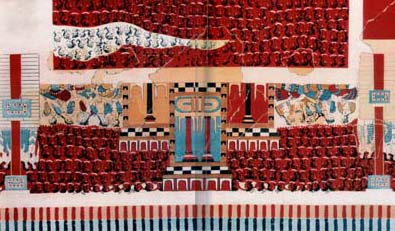
Arena scene fresco, Knossos, Crete, 1600 BCE. Minoans
crowded into the seats to watch bull leaping
(click to enlarge)
The DIsk is one of the most extraordinary artifacts ever discovered, and the Minoan civilization that produced it is one of the most accomplished civilizations ever to have existed on earth, yet so few people know about it compared to how many people know about the ancient Egyptian civilization. I can offer two explanations for this. One, the Minoan civilization was, and still is, overshadowed by the Egyptian civilization with which it co-existed. It was tiny compared with vast Egypt, flourishing isolated on an island off the coast of Egypt, in the middle of the Aegean Sea. Two, the people who know about the Minoan civilization have difficulty accepting the magnitude of its brilliance because it just seems too incredible to be true.
Perhaps the Minoan world causes a case of civilization envy for the observer, and this may also explain the denial. How can there be a 1,200 year-old Bronze Age culture flourishing without war, without politics, without corruption and murder as a mainstay but instead focused on art, astronomy, architecture, invention, and dancing? Longevity might have something to do with it. First settled in 128,000 BCE, Crete had plenty of time to get it right, and it seems the Minoans did.
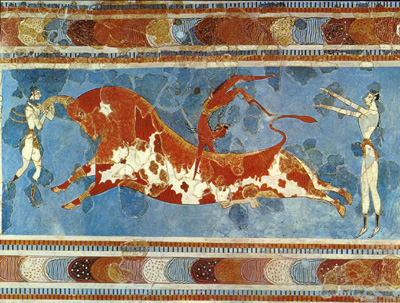
Bull Leaping fresco, Knossos, Crete
Will Durant believed we are arrogant in our perspective on the Minoan civilization that he said was "one of the most artistic civilizations in history," and the more I discover about it, the more I agree with him. By working closely with the Phaistos Disk for so many years I have gained a perspective of my own that makes me in awe of this ancient culture. Just a look at their cilvilization, their art, their technology, their science, their architecture, their beliefs, their lifestyle, and their Phaistos Disk, will astonish anyone no matter what they believe about intellect and achievement. My solution to the Phaistos Disk, so difficult for some people to accept because of what it reveals, shows just one incredible accomplishment out of many for this brilliant lost world, lost in more ways perhaps than we are willing to admit.

For further research and investigation into the disk and its cosmic significance, I highly recommend Watson's work. I believe that her insights into this enigmatic artifact will, in time, prove to be the most accurate. (Peter Sterling, Harp Magic)
BRILLIANT ANCIENT WORLD
In Middle Minoan I (2200 - 1500 BCE) the earliest palaces occur: the princes of Cnossus, Phaestus, and Mallia build for themselves luxurious dwellings with countless rooms, spacious storehouses, specialized workshops, altars and temples, and great drainage conduits that startle the arrogant Occidental eye. (Will Durant, Life of Greece)
According to popular legends of this Greek island in the Mediterranean Sea, Crete had many active ports, a powerful and unchallenged navy, beautiful palaces, superb architects, excellent hydraulic engineers, and people who love bull sports. They also had Daedalus, the world's greatest inventor. We call them Minoans but perhaps Daedalus, meaning "clever worker," was actually the name they gave their civilization, taking pride in their ingenuity.
This Bronze Age originality, inventiveness, and prosperity was no defense against the volcano, the earthquakes and the tidal wave that apparently destroyed the Minoan civilization in just one day and night. Is this account of the place really true or has it been romanticized by writers? Could this place have engendered the legend of Atlantis?
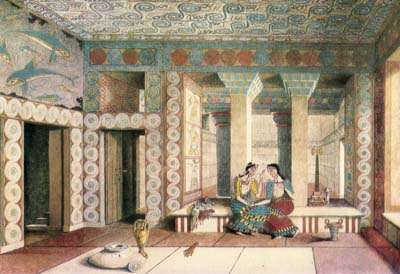
From our perspective the Minoan civilization seems too advanced to be compatible with our ideas about the Mediterranean Bronze Age, but perhaps that is because we know so little about it. Minoans invented paved roads, and paved them with shells and rocks. From all accounts of the people they lived comfortably in adobe townhomes with rooftop patios (below, Minoans houses) and enjoyed plumbing and bathtubs. The queen's bathroom at Knossos had a flushing toilet. Perhaps we aren't as smart as we think we are since we didn't have flushing toilets again until 3,000 years later. (above, Queen's bathroom, Knossos, with disks and spirals, click to enlarge.)
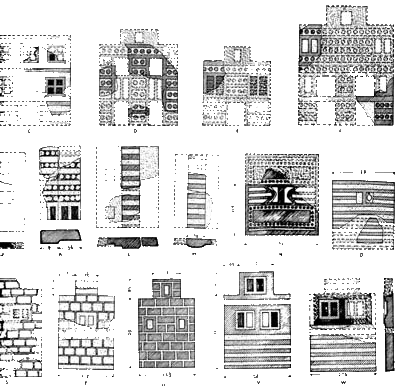
Minoan houses
The gay frescos on the walls of the palaces portray the people as wealthy, carefree, happy, sophisticated, uninhibited and artistic. They apparently lived well, they much enjoyed the companionship of dogs, and had a healthy diet of pork, fowl, fish, crab, corn, fruit, olives and vegetables, seasoned with herbs. (above, Minoan fresco, Saffron Gatherer, click to enlarge)
Crete had four major palace cities - Knossos, Phaistos, Mallia and Zakro. Durant said the palace at Phaistos was "a palace only less extensive than that of the Cnossus kings." He continues:
Phaestus becomes a Cretan Piraeus, in love with commerce rather than with art. And yet the palace of its prince is a majestic edifice, reached by a flight of steps forty-five feet wide; its halls and courts compare with those at Cnossus; its central court is a paved quadrangle of ten thousand square feet; its megaron, or reception room, is three thousand square feet in area, larger even than the great Hall of the Double Ax in the northern capital. (Durant)
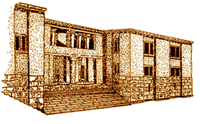 At Phaestus, about 2000, he builds ten tiers of stone seats, running some eighty feet along a wall overlooking a flagged court. (Durant) (Below, my photographs of Phaistos)
At Phaestus, about 2000, he builds ten tiers of stone seats, running some eighty feet along a wall overlooking a flagged court. (Durant) (Below, my photographs of Phaistos)
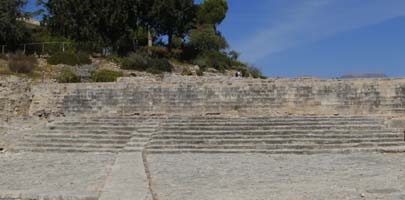
Steps along the wall, Phaistos Palace, October 2013
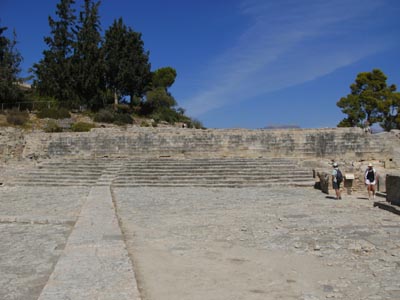 Phaistos Palace
 Phaistos Palace
|
The incredible view from Phaistos, Crete at Phaistos Palace
The central court, probably used for dancing, would have accommodated hundreds of dancers. These were early Greeks, so it is hard to imagine the large central courts of the palaces were not used for dancing. Probably they danced in spirals. Greek dancers still dance the pyrrhic, or Armed Dance, sometimes called Kronou Teknophagia, meaning "Crane Dance" and the "Dance of the Labyrinth." In the tradition of this dance, the movements are performed from right to left, then left to right, then stationary or slowly before an altar. Historically as well, Homer, in Chapter 18 of The Iliad, gives an account of a dance floor designed by Daedalus for Ariadne at Knossos, where the dancers would dance in circles and then dance in lines.

Minoan fresco, Dancing at the Sacred Tree
A painting from Cnossus preserves a group of aristocratic ladies, surrounded by their gallants, watching a dance by gaily petticoated girls in an olive grove; another represents a "Dancing Woman" with flying tresses and extended arms; others show us rustic folk dances, or the wild dance of priests, priestesses, and worshipers before an idol or a sacred tree. Homer describes the 'dancing-floor which once, in broad Cnossus, Daedalus made for Ariadne of the lovely hair; there youths and seductive maidens join hands in the dance.... and a divine bard sets the time to the sound of the lyre. (Durant)
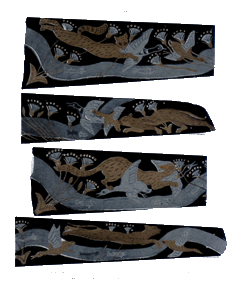
Hereon there danced youths and maidens whom all would woo, with their hands on one another's wrists. The maidens wore robes of light linen, and the youths well woven shirts that were slightly oiled. The girls were crowned with garlands, while the young men had daggers of gold that hung by silver baldrics; (left, engraved dagger hilts, click to enlarge) sometimes they would dance deftly in a ring with merry twinkling feet, as it were a potter sitting at his work and making trial of his wheel to see whether it will run, and sometimes they would go all in line with one another, and much people was gathered joyously about the green. (Homer, The Iliad)
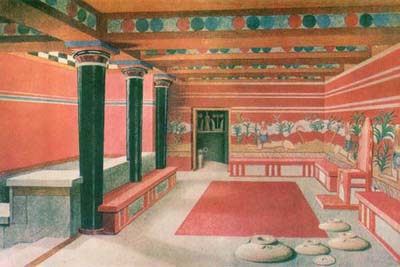
Reconstructed Throne room with disks, Palace at Knossos
If Phaistos was overshadowed by Knossos alone, it must have been a magnificent palace. Knossos was as big as Buckingham Palace, with 800 rooms covering 6-1/2 acres, and with designs on the walls called "Figure 8 Shields." These shields have been mysterious, but with the round maze of the Phaistos Disk in mind and its maze solution in hand, the design makes sense and the meaning seems clear.

It would appear that before Zeus-Dionysus was depicted in human shape he was worshipped through his symbols
or attributes. Another symbol of the god was the 8-form shield. (Mackenzie, Minoan fresco, Figure 8 Shields and spirals) (Below, my photographs of Knossos)
|
 Knossos Palace, Crete
 Knossos Palace, Crete
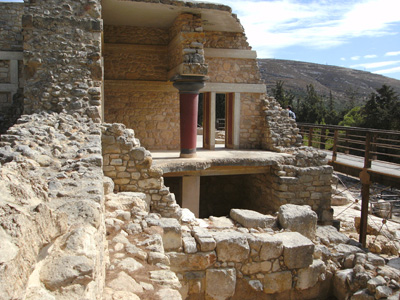 Knossos Palace, Crete
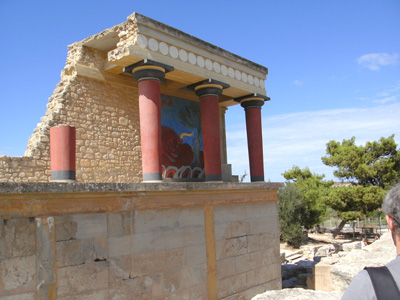 Bull Charging an Olive Tree fresco, Knossos Palace, Crete
 Knossos jars, Knossos Palace, Crete
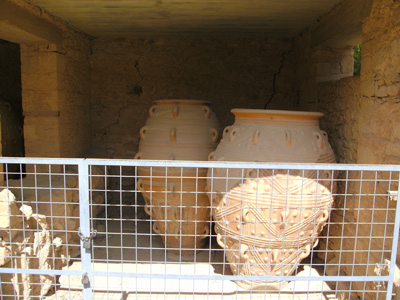 Knossos jars, Knossos Palace, Crete
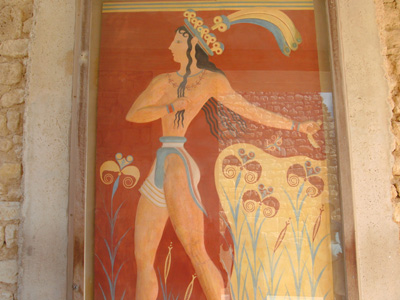 Crested Dancer fresco, Knossos Palace, Crete
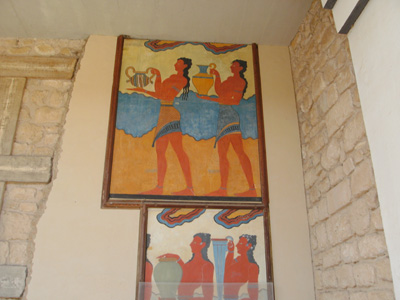 Knossos fresco, Knossos Palace, Crete
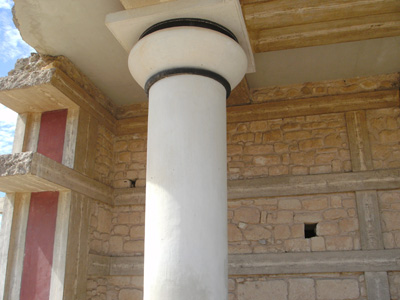 Upside-down Doric column, Knossos Palace, Crete
 The View from Knossos Palace, Crete
|
 The walls of the palaces are often covered in spirals like a labyrinth, the word originating as Labrys and also meaning "axe." The palace at Knossos was like a maze, with endless passageways and rooms, and supposedly designed by Daedalus. Some say the palace might be the Maze of Daedalus.
The walls of the palaces are often covered in spirals like a labyrinth, the word originating as Labrys and also meaning "axe." The palace at Knossos was like a maze, with endless passageways and rooms, and supposedly designed by Daedalus. Some say the palace might be the Maze of Daedalus.
Was Daedalus the creator of the Phaistos Disk, or was Daedalus the collective name of the brilliant Bronze Age artisans who lived and worked back then? They were incredibly creative. Is Crete the root word for create? They created palaces, designed mazes, made bronze armor and weapons, painted beautiful murals and frescoes, made exquisite pottery, designed drainage systems, built trading ships, and they had a fascination with bulls. Not just at Knossos, where the palace roof tops were trimmed in bull's horns and the walls display images of bull sports, but also other places like Mallia, where the palace is designed like the head of a bull. And then, of course, there is the world-famous legend of the Minotaur, a half-bull, half-human creature contained by Daedalus inside the maze.

Bull's horn symbol at Knossos Palace, Crete
 Bull worship, bull sports and bull symbolism make the Minoans so interesting; all that brilliant art and technology and still a focus on the bull? After
Bull worship, bull sports and bull symbolism make the Minoans so interesting; all that brilliant art and technology and still a focus on the bull? After 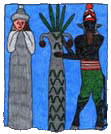 perhaps as many as 25,000 preceding years of bull worship, it is not surprising that the bull figured significantly in their civilization. Egypt had its Serapis – the sacred Osiris-Apis bull. Baal was widely worshipped, the Israelites had their golden calf Moshe (Moses), and painted on the walls of buildings in ancient Sumer are humans with horns. The horns tell of their status as gods and goddesses. (Bull goddess and god of Susa, left, Minotaur, right, Minoan Queen Pasiphae by Picasso, below)
perhaps as many as 25,000 preceding years of bull worship, it is not surprising that the bull figured significantly in their civilization. Egypt had its Serapis – the sacred Osiris-Apis bull. Baal was widely worshipped, the Israelites had their golden calf Moshe (Moses), and painted on the walls of buildings in ancient Sumer are humans with horns. The horns tell of their status as gods and goddesses. (Bull goddess and god of Susa, left, Minotaur, right, Minoan Queen Pasiphae by Picasso, below)
 The idea of the bull-god is foreign to us, although it should not be. Even today in India the bull is sacred, and in Spain and Mexico bull sports are still popular, as are rodeos in the U.S. In Crete, the bull apparently was at the center of both religion and sport. This history of bull-worship clears up some of the mystery of the Cretan legend of the Minotaur, a bull-being at the center of the bull sports and the maze. It clears up some mystery about Zeus, the Greek god who often appeared as a bull. And it also shines some light on the worship of the bull-born Dionysis. Perhaps the bull was connected somehow to the idea of wealth.
The idea of the bull-god is foreign to us, although it should not be. Even today in India the bull is sacred, and in Spain and Mexico bull sports are still popular, as are rodeos in the U.S. In Crete, the bull apparently was at the center of both religion and sport. This history of bull-worship clears up some of the mystery of the Cretan legend of the Minotaur, a bull-being at the center of the bull sports and the maze. It clears up some mystery about Zeus, the Greek god who often appeared as a bull. And it also shines some light on the worship of the bull-born Dionysis. Perhaps the bull was connected somehow to the idea of wealth.
Greece had almost forgotten, though the poet (Homer) had not, that the island whose wealth seemed to him even then so great had once been wealthier still; that it had held sway with a powerful fleet over most of the Aegean and part of mainland Greece; and that it had developed, a thousand years before the siege of Troy, one of the most artistic civilizations in history. Probably it was this Aegean culture—as ancient to him as he is to us— that Homer recalled when he spoke of a Golden Age in which men had been more civilized, and life more refined, than in his own disordered time. (Durant)

How long ago is 3,600 years? The Minoan world is so far in the distant past that the Greek poet Homer in 700 BCE called it ancient and forgotten. This fabulous civilization that ended so suddenly is often said to have engendered the myth of fabled Atlantis. From that dazzling, lost world we have the Phaistos Disk, something like a message in a bottle but excavated over 100 years ago beneath the ruins of a palace instead of washed up on a beach. (Left, Shield Ritual room with disks, spirals and shields, Knossos, Crete, click to enlarge)
To some people it seems unimaginable that a Bronze Age artist could create this incredible disk, and so of course it has been suggested it is a fake. How much more unimaginable it would be to the artist(s) that this great puzzle masterpiece could re-emerge in a world incapable of recognizing it, solving it, and then understanding it. The Phaistos Disk is a portal to this ancient world - a bridge between worlds - connecting us to the old world-view and original ideas long forgotten.
Page 1 - Ancient Puzzle Solved | Brilliant Ancient World
Page 2 - Interview with Jonas | Valuable Background in Bridge
Common Approach | Can You Read the Phaistos Disk?
Self-Hypnosis
Part 3 - Dream Perspective | Great Pyramid, Exterior
Two Pyramids?
Part 4 - Great Pyramid, Interior & Subterranean Chamber
Phaistos Disk Maze of Daedalus
Part 5 - Great Star in the Sky
Part 6 - Constellation Argo
Page 7 - Pre-Euclidean Geometry | Minoan Fashion
Page 8 - Solve the Maze | Minoan Pottery
Page 9 - Minoan Calendars | Minoan Lunisolar Calendar
Zodiac Stellar Calendar | Minoan Sothic Calendar
Minoan 366-Day Year | How Was the Phaistos Disk Made?
Page 10 - Phaistos Disk Pictographs
Page 11 - Fishing Lessons | Big Game Hunter
First Woman Airline Pilot | The Stearman | The AT-6
Page 12 - Brilliant Musician | Debutant Career | English Teacher
Booted Out of School | Hostess Career
Page 13 - Crash Landing | Marauder Pilot | Bridge Boyfriend
Dedicated to Billy | Money Bridge Pro
Archaeoastronomer Career
DISK OF THE WORLD
A Spiritual Revelation about the Enlightenment and its Social Repression
Copyright Notice - Disk of the World - Text and images copyrighted March 21, 1993-2023,
Claire Grace Watson, B.A., M.S.T., U.S. Copyright and under the Digital Millennium Copyright Act of 1998, All rights reserved.
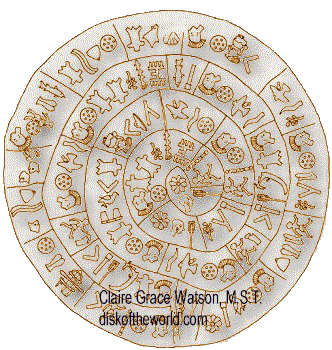



![]() This pictograph on the Phaistos Disk that looks like a carpenter's square appears exactly six times on one side of the two-sided Disk. The pictograph is #17 in the right column of the pictographs found on the Disk. Connect these matching pictographs with lines to excavate a pyramid, drawn as in geometry to indicate four sides. The Great Pyramid Is just across the water from Crete. Is this new pictograph the Great Pyramid? Could the Minoans have known how it was built or is this a speculation on how it was built?
This pictograph on the Phaistos Disk that looks like a carpenter's square appears exactly six times on one side of the two-sided Disk. The pictograph is #17 in the right column of the pictographs found on the Disk. Connect these matching pictographs with lines to excavate a pyramid, drawn as in geometry to indicate four sides. The Great Pyramid Is just across the water from Crete. Is this new pictograph the Great Pyramid? Could the Minoans have known how it was built or is this a speculation on how it was built?![]()
![]()
![]()
![]()
![]()
![]()
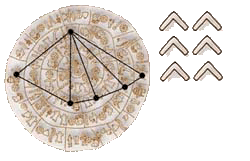
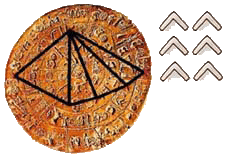
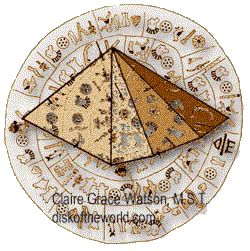
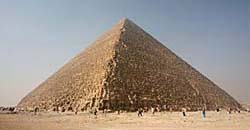
![]()
![]()
![]()
![]()
![]()
![]()

![]() "Carpenter's squares (geometry) built this." (Not aliens :)
"Carpenter's squares (geometry) built this." (Not aliens :)![]() Excavate the interior of the Great Pyramid showing the entrance to the subterranean chamber by connecting with lines all the 10 Golden Fleece pictographs (left) on Side 1. This is pictograph #9 in the right column. Suddenly appears a new pictograph, #50, the Great Pyramid with a view of the interior showing the entrance leading to the subterranean chamber.
Excavate the interior of the Great Pyramid showing the entrance to the subterranean chamber by connecting with lines all the 10 Golden Fleece pictographs (left) on Side 1. This is pictograph #9 in the right column. Suddenly appears a new pictograph, #50, the Great Pyramid with a view of the interior showing the entrance leading to the subterranean chamber. 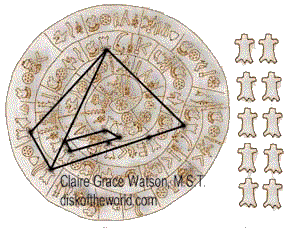
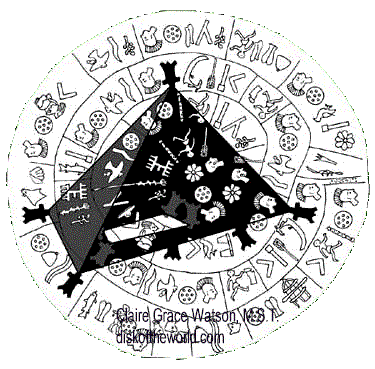





![]()

![]()
![]()
![]()
![]()
![]()
![]()
 At Phaestus, about 2000, he builds ten tiers of stone seats, running some eighty feet along a wall overlooking a flagged court. (Durant) (Below, my photographs of Phaistos)
At Phaestus, about 2000, he builds ten tiers of stone seats, running some eighty feet along a wall overlooking a flagged court. (Durant) (Below, my photographs of Phaistos)


















![]() The walls of the palaces are often covered in spirals like a labyrinth, the word originating as Labrys and also meaning "axe." The palace at Knossos was like a maze, with endless passageways and rooms, and supposedly designed by Daedalus. Some say the palace might be the Maze of Daedalus.
The walls of the palaces are often covered in spirals like a labyrinth, the word originating as Labrys and also meaning "axe." The palace at Knossos was like a maze, with endless passageways and rooms, and supposedly designed by Daedalus. Some say the palace might be the Maze of Daedalus. 
 Bull worship, bull sports and bull symbolism make the Minoans so interesting; all that brilliant art and technology and still a focus on the bull? After
Bull worship, bull sports and bull symbolism make the Minoans so interesting; all that brilliant art and technology and still a focus on the bull? After  perhaps as many as 25,000 preceding years of bull worship, it is not surprising that the bull figured significantly in their civilization. Egypt had its Serapis – the sacred Osiris-Apis bull. Baal was widely worshipped, the Israelites had their golden calf Moshe (Moses), and painted on the walls of buildings in ancient Sumer are humans with horns. The horns tell of their status as gods and goddesses. (Bull goddess and god of Susa, left, Minotaur, right, Minoan Queen Pasiphae by Picasso, below)
perhaps as many as 25,000 preceding years of bull worship, it is not surprising that the bull figured significantly in their civilization. Egypt had its Serapis – the sacred Osiris-Apis bull. Baal was widely worshipped, the Israelites had their golden calf Moshe (Moses), and painted on the walls of buildings in ancient Sumer are humans with horns. The horns tell of their status as gods and goddesses. (Bull goddess and god of Susa, left, Minotaur, right, Minoan Queen Pasiphae by Picasso, below)
 The idea of the bull-god is foreign to us, although it should not be. Even today in India the bull is sacred, and in Spain and Mexico bull sports are still popular, as are rodeos in the U.S. In Crete, the bull apparently was at the center of both religion and sport. This history of bull-worship clears up some of the mystery of the Cretan legend of the Minotaur, a bull-being at the center of the bull sports and the maze. It clears up some mystery about Zeus, the Greek god who often appeared as a bull. And it also shines some light on the worship of the bull-born Dionysis. Perhaps the bull was connected somehow to the idea of wealth.
The idea of the bull-god is foreign to us, although it should not be. Even today in India the bull is sacred, and in Spain and Mexico bull sports are still popular, as are rodeos in the U.S. In Crete, the bull apparently was at the center of both religion and sport. This history of bull-worship clears up some of the mystery of the Cretan legend of the Minotaur, a bull-being at the center of the bull sports and the maze. It clears up some mystery about Zeus, the Greek god who often appeared as a bull. And it also shines some light on the worship of the bull-born Dionysis. Perhaps the bull was connected somehow to the idea of wealth.